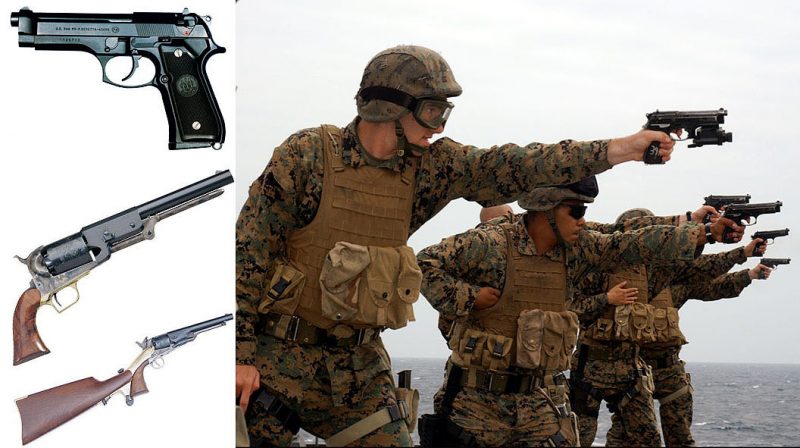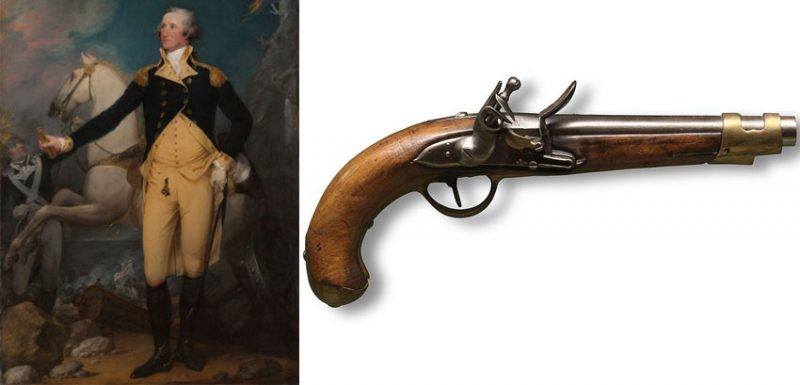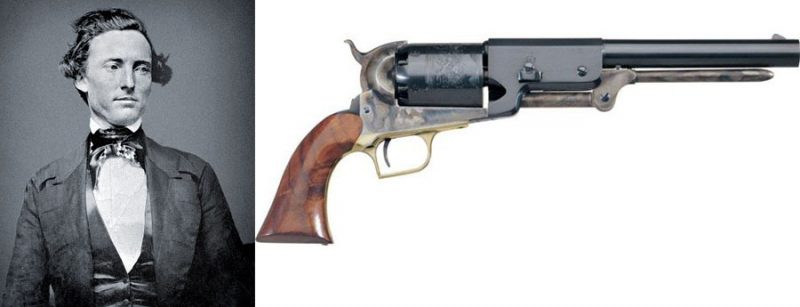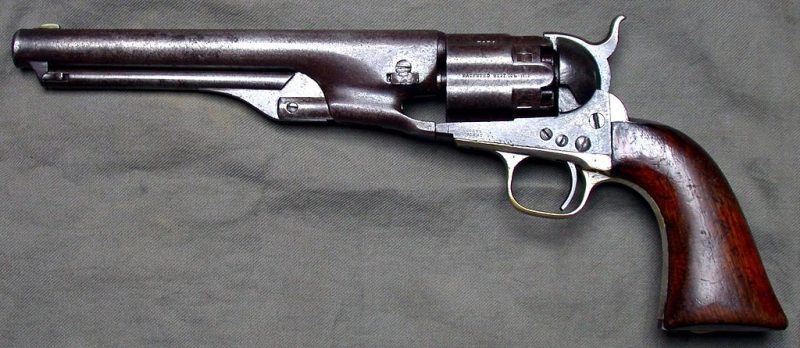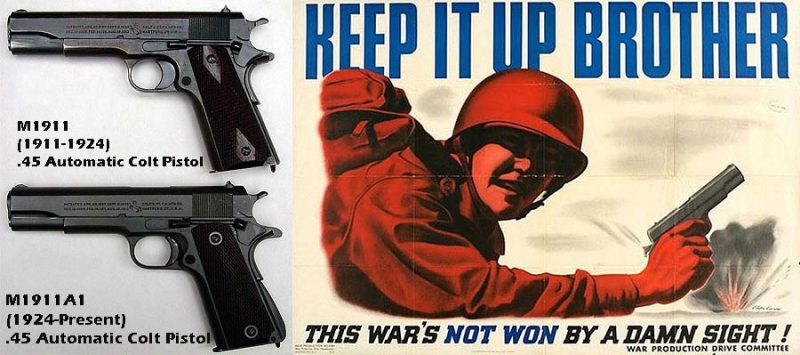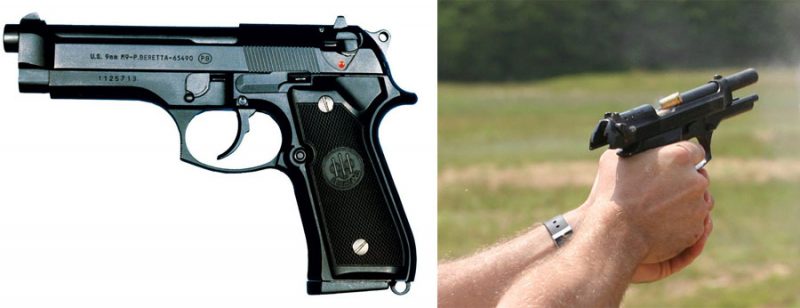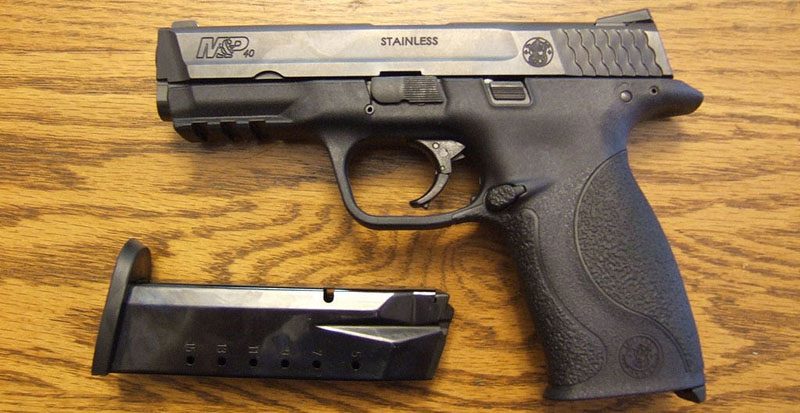Images Used (Clockwise from top Left): (1) A Beretta M9 (2) US Marines on board the USS Blue Ridge and training with Beretta M9 pistols (3) A Shoulder stock mounted Colt Army Model 1860 revolver (4) According to some historians, the 1847 Colt Walker Revolvers had been the most powerful handguns ever built until the advent of the .357 Magnums in the 1930s
The largest branch of US Armed Forces is the US Army which was formed in 1775. To provide light firepower at shorter ranges, the Army has been using various individual weapons during its 240 years of glorious history. Beside the rifles and other weapons, the primary sidearm in the US Army has been the 9mm Beretta M9 semiautomatic pistols since 1985. CNNMoney, the financial news and information website operated by CNN division of Time Warner, reported that US Army had taken initiatives to replace the Beretta recently. The website also looked back at 4 other older Army pistol models and hinted on the next possible official handgun in the US Army. After being in service for 30 years, several thousand 9mm M11 pistols and over 200,000 Cold War era 9mm M9 pistols are going to be replaced at the cost of hundreds of millions of dollars by United States Government for US Army due to these being outdated and for greater reliability, accuracy, durability and lethality. We take a look at the great guns in the history of US Army.
(1) French Flintlock Saddle Pistols, Used by General Washington:
The 8 year long American Revolutionary War started in April, 1775 and the US Army was formed hastily in June, 1775 without any standard-issue pistols. Officers had to supply their own weapons and that included the General George Washington who carried two Flintlock saddle pistols given to him by his French ally and friend, Marquis de Lafayette.
Flintlock is a general term for firearms which are based on flintlock mechanism which was used on rifles and muskets from 17th to 19th centuries. The technology was invented in France in the early 17th century. Flintlock mechanism has a piece of flint (a type of shiny stone) attached to the end of a short hammer, when the hammer is cocked and then released, the flint strikes the opening cover of a pan that contains gunpowder and ignites the powder to fire the weapon.
Flintlocks were hard to reload and it was not that consistent in firing like the guns we know today. The sizes and styles of Flintlock pistols were not well defined and varied. It could be 6 inches (152.4 mm) to 20 inches (508 mm). General Washington carried the Flintlock pistols throughout the Revolutionary War. These were kept by him through his presidency until his death.
Images Used (From Left): (1) General Washington at Trenton illustrated by American artist John Trumbull in 1792 after the American Revolutionary war (2) A French Flitlock pistol from around the 1790s
(2) Colt Walker Revolver:
This single action .44 caliber lead balls revolver was designed and developed in 1846 as collaboration between American gun inventor Samuel Colt and a Texas Ranger Captain Samuel Walker. Caliber is the diameter of the bullet or the internal diameter of the barrel and 0.45 calibers means the mentioned diameters being 0.45 inch or 11.43 mm. There are numerous types of trigger actions, such as- single action, double action etc. To get the idea of single action, it is better to have an understanding of double action triggering. Double action means 2 actions are performed upon pulling the trigger- it cocks and then fires the hammer. Like in the revolvers, one can cock the hammer using the thumb then pull the trigger and in this case the trigger performs single action. In single action, trigger pull requires less force; hand doesn’t shake much while pulling the trigger and allows more accurate shooting.
It had a length of 15.5 in (390mm) and 1,100 units were produced. It was one of the most powerful black powder revolvers. The Colt Walker had a very large cylinder and consumed a lot more black powder than other black powder guns of its time. Samuel Walker wanted an extremely powerful handgun at close range which was reflected in the Colt Walker first produced in 1847. It was used in the Mexican-American War fought from 1846 to 1848. Walker was killed in the War shortly after he received the guns he produced. The gun became popular when 15 Texan Rangers used the newly invented Colt Walkers to outgun 70 Comanche soldiers in 1847. Historians Gerry and Janet Souter even wrote in their book ‘Guns of Outlaws- Weapons of the American Bad Man’ that in a battle during the Mexican-American War, around 500 Mexican soldiers were comprehensively defeated by 70 US soldiers using Colt Walker revolvers. They also added that Colt Walker had been the most powerful handguns ever built until the advent of the .357 Magnums in the 1930s.
Images Used (From Left): (1) Texas Ranger Captain Samuel Walker (1817-1847), the co-developer of the Colt Walker Revolver (2) Historians Gerry and Janet Souter mentioned in their book that the 1847 Colt Walker Revolvers had been the most powerful handguns ever built until the advent of the .357 Magnums in the 1930s
(3) Colt Army Model 1860 Revolver:
A revolver has a revolving cylinder that contains multiple cartridge chambers. Colt Army Model 1860 was a .44 caliber (0.44 inch or 11.17 mm), cap & ball revolver which had a loading lever to ram the firing chamber contents down the percussion cap. Percussion cap is a small cylinder of brass or copper with one closed end explosive materials inside it. It detonates upon being struck a sharp blow by the firing pin of a gun. Colt 1860 was used during the American Civil War which could be considered to be the first modern warfare. Cutting edge technologies like the train, telegraph, airships and repeater rifles. Repeater rifles and revolvers used advanced technologies than the flintlock muskets. The Colt factory in Connecticut and most of the other firearms factories were in the Northern regions of United States and that’s how the Union got the Colt Model 1860 Revolvers. Though the loading lever based cap and ball system was not that easy to load like the modern cartridges, with six shots in the cylinder, the Union soldiers had a competitive superiority over the single-shot flintlocks.
Image Used: A Colt Army Model 1860 Revolver
(4) Colt M1911 pistol:
American firearms manufacturer ‘Colt’s Manufacturing Company’ was founded in 1855. Colt M1911 pistol served as the official sidearm for the US Armed forces from 1911 and 1985. It is a 0.45 caliber semi automatic, single-action, recoil operated, magazine fed pistol.
Semi automatic means it fires one round each time the trigger is pulled. Recoil operation is based on Newton’s third law of motion which says that there is an equal and opposite reaction for every action. So, when a bullet leaves the barrel, the hand holding the firearm feels strong recoil in the opposite direction. All firearms use four types of automatic operations. In recoil operation, the entire firearm doesn’t recoil upon firing the bullet. Only a sliding portion of the weapon is allowed to recoil while the rest of the weapon remains motionless with respect to the recoiling parts. Recoiling and non recoiling parts are connected with a spring.
Over 2.7 million of the M1911s and M1911A1s were produced. M1911 was designed in 1911 and the M1911A1 was designed in 1924. These hand guns were widely used as service pistols in WWI, WWII, Korean War and Vietnam War. In Persian Gulf War, War in Afghanistan and in the Iraq war, there were non-standard usages of the Colt M1911s. These guns were not completely phased out even after the introduction of Beretta M9 due to the popularity of M1911s. M1991, a special variant of this handgun is still in use by some units of the US Navy, US Army Special Forces and US Marine Corps.
68,533 Colt M1911s were used by US forces during the WWI. Due to the expansion of the war, beside Colt, other firearms manufacturers also got the contracts to produce army weapons including the M1911. US Government procured 1.9 million M1911s and M1911A1s from different manufacturers during the WWII. M1911A1s were favored by both US and Allied combatants due to its smaller size. British commando units, British Special Operations Executive unit and Commonwealth South African forces prized the M1911A1s during the WWII.
Images Used (From Left): (1) Comparison between standard-issue M1911 and M1911A1 handguns (2) The Colt pistols appeared in WWII recruiting posters
https://www.youtube.com/watch?v=Ro7N7dAmjLY
Video Used: WWII Combat Handgun training video with the .45 caliber M1911s
(5) Beretta M9:
Beretta M9 pistols have been manufactured by ‘Fabbrica d’Armi Pietro Beretta’, the Italian based multinational weapons manufacturer. It is a .354 caliber (0.354 inch or 9 mm), 9×19mm Parabellum semiautomatic pistol. The 9×19mm Parabellum cartridges were designed by Austrian firearms designer Georg Luger and was manufactured by German weapons manufacturer DWM for the German Luger pistols. The name Parabellum is originated from the Latin phrase ‘Si vis pacem, para bellum’ which means ‘If you seek peace, prepare for war’. This phrase is also the motto of DWM. With its wide availability and low cost, Parabellum is the world’s most popular and widely used military pistol cartridge. Over 60% police in the United States use these cartridges.
The Beretta M9 won the bid in the 1980s to replace the M1911A1 as the standard-issue primary sidearm of the US Army, Navy and Air Force. There were many contenders and the last battle was between Italian M9 and the German-Swedish SIG P226. Eventually, Beretta M9 was selected due to cost reasons. It has a length of 8.5 in (217 mm) and weighs 2.56 lbs or 1.16 kg. It uses a short recoil and single or double action technology with a 15 round box magazine. The lifetime of a M9 is expected to be 25,000 rounds. The handguns were used as standard issue handgun in the Invasion of Panama, Persian Gulf War, War in Yugoslavia and War in Afghanistan. In 2006, M9 design was upgraded to M9A1 and limited numbers were issued to US Marine Corps.
Due to some performance debates, Beretta came up with its M9A3 upgrades in December 2014. However, United States army decided not to evaluate M9A3 and opted for purchasing new service handguns due to a cost-benefit analysis showed that new purchases would be cheaper than refurbishing old M9 pistols.
Images Used (From Left): (1) A Beretta M9 (2) A cartridge casing being ejected during firing of a Beretta M9
(6) US Army Pistols of the Future, Possibly the Smith & Wesson M&P Pistols:
American firearms manufacturer Smith & Wesson is expected to become the next handgun supplier for the US Army. The weapon manufacturer was founded in 1852 and is headquartered in Springfield, Massachusetts. It is planning to submit its lightweight M&P (Military and Police) pistols as a contender of becoming the standard-issue handgun of the US armed forces. M&P is a polymer-framed, locked breech, short recoil operated, semi automatic pistol.
Besides targeting the law enforcement agencies as potential buyers, M&Ps are also obtainable in the commercial market. These polymer pistols have become quite popular among cops and civilians. The US army did not specify frame material of the gun, but asked for a powerful handgun. The M&P provides an improved trigger weight; it has got an internal lock option and an external thumb safety. A number of armed forces in around 24 countries and some UN security forces are users of the M&Ps.
Image Used: A .40 caliber (.40 inch or 10.16 mm) Smith & Wesson M&P handgun
